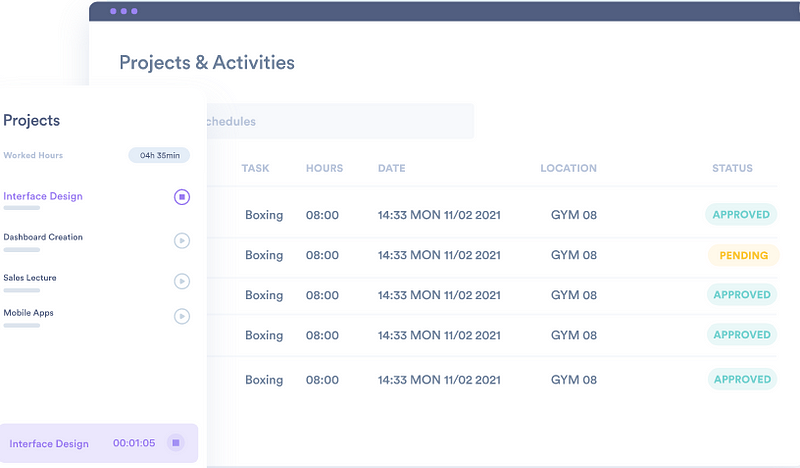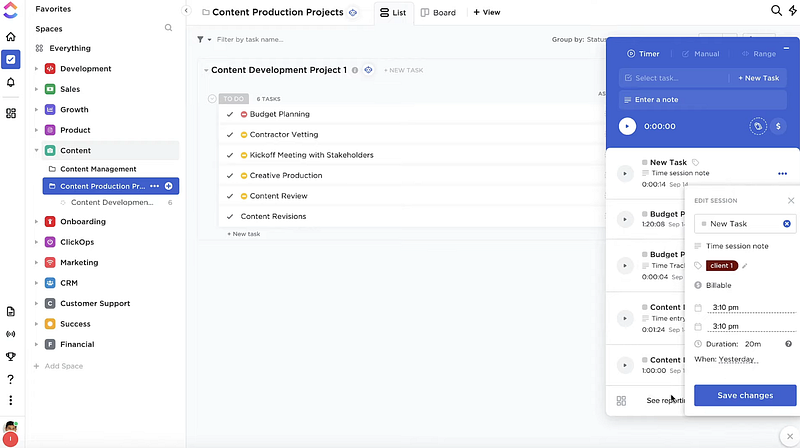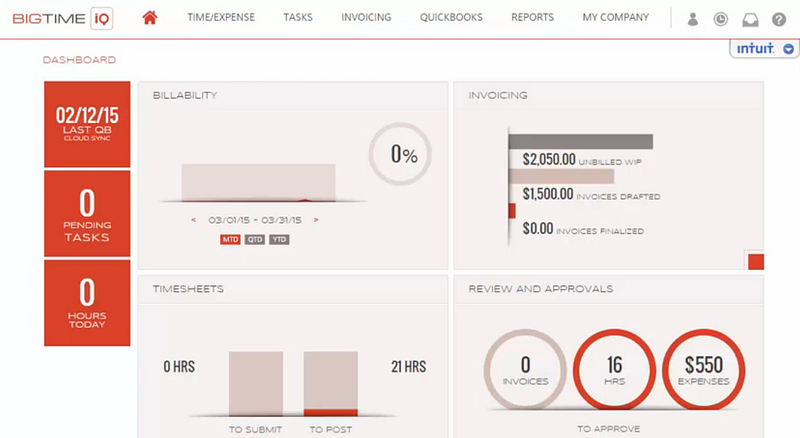Do you know that companies can lose up to $50,000 per employee annually simply because they don’t monitor the time spent on activities such as responding to client emails? That’s a massive amount of money that could be reinvested in scaling your business. Fortunately, leveraging real-time project time tracking can help you avert these losses and unlock additional benefits.
Today, we’ll explore how real-time project time tracking can revolutionize your company, the best methods for efficient implementation, typical obstacles and how to surmount them, and the most effective project time tracking software.
Get ready to seize control of your time and maximize your profitability with the power of real-time insights.
Throughout this article, we’ll cover:
- What is Real-time Project Time Tracking?
- Benefits of Real-time Project Time Tracking
- Strategies for Implementing Effective Project Management Time Tracking
- Time and Project Tracking: Common Challenges and How to Overcome?
- Best Project Time Tracking Software
- Wrap-up: Leverage Project Time Reporting for Enhanced Profitability

What is Real-time Project Time Tracking?
Real-time project time tracking is a process that monitors, records and reports the time spent on projects and tasks. By tracking when employees start and finish work, how long they spend working, who works together on a task, or how many hours are billed for each job—companies can gain valuable insights into their business operations.
Project managers use various time tracking methods such as timesheets, punch cards, and invoicing systems to monitor employees’ work hours. With real-time tracking, companies can get an accurate picture of the actual resources used for a given project or task—enabling them to adjust their budget accordingly.

15 Benefits of Real-time Project Time Tracking
When you have real-time insights into how your projects are progressing, it can help you make better decisions and ultimately boost profitability. Here are a few of the main benefits of real-time project time tracking:
1. Finding Out Bottlenecks
Real-time project time tracking can help you identify bottlenecks and inefficiencies. You can quickly take corrective measures and make adjustments to your workflow. This enables you to maximize productivity and reduce time spent on a project or task.
For example, suppose you are the project manager of a laptop manufacturing plant and notice that the production process is taking longer than expected during the final assembly stage. In that case, you can identify the bottlenecks and improve the process. This will help you save time and money in the long run.
2. Accurate Information on Productivity and Timeline
As a project manager, you need accurate information on the progress of projects to determine whether they are on track or not. With real-time tracking, you can easily monitor the progress of your projects and make sure that all tasks are completed within the allotted timeline. This helps you stay organized and informed about all aspects of your business.
3. Improved Training Need Assessment
Project time tracking can also assess training needs for employees involved in a specific project. Suppose a particular task takes longer than expected due to a lack of knowledge or experience. In that case, it’s easier to identify where extra training may be needed to make the team more efficient. This helps you save time and money by providing training only where it is required.
4. Better Resource Allocation
Real-time tracking can help you better allocate resources for different projects and tasks within a project. By analyzing the data collected from the monitoring, you can determine which areas need extra attention or require additional resources to meet deadlines efficiently.
5. Identifying Unproductive Activities
Project time tracking also enables you to identify unproductive activities that may take up valuable time and resources without yielding desirable results. You can then minimize or eliminate these activities to improve overall productivity.
6. Reduced Overhead Costs
Project time tracking helps you reduce overhead costs by streamlining operations and maximizing the efficiency of tasks. By better understanding how long each task takes, you can allocate resources more effectively and save money in the process. This also makes it easier to identify potential problems before they become too costly or challenging to fix.
7. Improved Customer Service
Efficient customer service is a top priority for any business. With real-time tracking, you can monitor your team’s performance and if they are meeting customer expectations.
You can also use this data to identify potential areas of improvement and make necessary changes. This will help you provide better customer service and increase customer satisfaction levels.

8. Better Client Billing Practices
When you have all of the real-time project tracking data available, you better understand how long it takes to complete a project. This can help you set realistic timelines and billing cycles for your clients.
You can also use the data to create accurate invoices that reflect the actual cost of labor and materials used in each project. This will ensure that your clients are billed accurately while receiving the best value for their money.
9. More Automation
You can automate specific processes if you can track and analyze project data and performance metrics in real-time. This will help reduce manual labor and increase the efficiency of your project management workflow.
You can also use automation to generate reports that provide an overview of performance metrics, such as time spent on tasks or costs associated with a project. These reports can be used for decision-making purposes.
10. Enhanced Accountability
Through continuous time tracking and feedback processes, you can foster greater accountability within your team. This will help you identify and address any potential issues before they become a problem.
It also helps ensure that all tasks are completed on time and to the highest quality standards. This will increase customer satisfaction levels and enhance your overall productivity.
11. Improved Employee Wellbeing
As you can always know the workload of each team member, you can ensure that they are not overworked or under-challenged. This will help create a better work-life balance for your employees and foster greater job satisfaction.
12. Greater Focus and Prioritization
By tracking project time and progress, you can identify essential tasks that must be addressed first. This will help your team prioritize workloads and focus on the most important things. This will ultimately result in improved productivity levels and better results for the company.

13. Efficient Human Resource Management
Real-time tracking helps you manage your resources more efficiently. You can track the time spent on each task, identify areas where you need to adjust staffing levels and measure overall productivity. This data can help you decide who is best suited for specific tasks and how many people are needed to complete a project within a given timeline.
14. Better Project Cost Estimation
One of the main benefits of real-time tracking is that it helps you estimate costs more accurately. By monitoring how much time is spent on each task, you can get a better idea of the actual cost of a project and make adjustments as needed. This will help you stay within budget and maximize profits.
15. Improved ROI and Monetary Results
Real-time tracking also gives you valuable insights into whether or not a particular project is worth investing in. By monitoring the progress of projects, you can identify any potential issues early on that could impact the ROI. This will help you make better decisions and maximize your profits.
Strategies for Implementing Effective Project Management Time Tracking
Real-time project time tracking can be used in various ways to improve efficiency and profitability. Here are some strategies for implementing effective project management time tracking:
- Establish clear timelines for each task or project. A timeline ensures that all employees know what is expected from them, when it needs to be completed, and who is responsible for which aspects of the work.
- Utilize employee monitoring software that records an individual’s time on a specific task or job. This information helps managers identify areas where they need to adjust their business operations.
- Analyze data collected through real-time tracking to identify trends and opportunities for improvement. This may involve examining the total time spent on a task, how often tasks are completed on-time, or which employees are more productive than others.
- Use project time reporting tools that provide insights into overall performance and allow managers to identify areas for improvement quickly.
Time and Project Tracking: Common Challenges and How to Overcome?
Real-time project time tracking can be challenging for businesses, especially if they don’t have the right tools. Here are some common challenges and strategies to overcome them:
Employee Resistance
Employees may not want to use a time-tracking system due to privacy or workload concerns. To address this issue, managers should explain how real-time project time tracking will benefit both the company and employees.
Time Accuracy
Data collected through real-time project time tracking must be accurate so companies can make informed decisions about their business operations. Companies should invest in quality employee monitoring software that accurately records time spent on each task.
Data Overload
Companies may struggle to make sense of the data collected through real-time tracking if they don’t have the right tools in place. To address this issue, businesses should use reporting tools that provide insights into overall performance and allow managers to identify areas for improvement quickly.
3 Best Project Time Tracking Software
When it comes to project time tracking, there are plenty of options available. Here are some of the best software:
1. Day.io – Overall, the Best Project Time Tracking Software for Small Businesses

Day.io is one of the most popular project time tracking software for small businesses, providing a comprehensive solution that includes real-time insights into how projects are progressing and where improvements can be made.
The software allows you to create detailed timesheets with customizable fields, store data securely in the cloud, and export it as PDFs or Excel spreadsheets. You can also use Day.io’s intuitive dashboard to track employee performance and see who works on what tasks at any given time.
Features
- Cross-device compatible time tracking
- Advanced and customizable project reports
- Configurable time clock for various platforms
- Employee scheduler with customizable tolerance for early-exit and late-entry
- Paid time off limit configuration and calculation
- Costs and billing details for detailed profitability analysis
- Timesheets with real-time project data
Pricing
Project time tracking: $6 per user/month
2. ClickUp – Excellent Project Management Tool with Built-in Time Tracker

ClickUp is hard to beat regarding project management but also provides an excellent time tracking feature. The software allows you to track employees’ hours and easily view all timesheets in one place. You can also set up automated reminders for team members so that they always know when their workdays are over.
The real-time insights ClickUp provides make it easy to spot problems and inefficiencies before they become major issues, enabling managers to make data-driven decisions quickly and accurately.
Features
- Full range of project management features
- Different task views, including Gantt chart
- Time tracking with customizable fields
- Automatic reminders for team members
- Integration with third-party tools
- Advanced project analytics and reporting
Pricing
- Unlimited: $9 per user/month
- Business: $19 per user/month
- Business Plus: $29 per user/month
3. BigTime – Expense Management and Project Time Reporting App

BigTime is an all-in-one time tracking and expense management app. The software allows you to track expenses, manage invoices, and monitor employee performance in real time. BigTime’s comprehensive expense tracking feature is a great way to keep tabs on project costs and ensure they stay within budget.
The app also offers detailed reports, giving you an in-depth view of how projects are progressing so that you can adjust your strategy accordingly.
Features
- Time tracking with detailed reporting
- Expense management, including invoice tracking
- Project performance monitoring
- Real-time project data and insights
- Employee scheduling and time clock options
Pricing
- Express: $10 per user/month
- Pro: $30 per user/month
- Premier: $40 per user/month

Wrap-up: Leverage Project Time Reporting for Enhanced Profitability
Businesses can gain valuable insights into their operations by continuously tracking and reporting the time spent on each project or task. This helps managers identify areas for improvement quickly and adjust their strategies to maximize efficiency and profitability. With the right project management time-tracking software, companies can leverage data-driven decision-making to make more informed decisions optimized for success.
If you’re looking for the best project time tracking software for small businesses, Day.io is an excellent option. With its intuitive user interface and powerful reporting features, Day.io makes tracking time on projects and tasks easy and accurate. Try Day.io today and see how it can help you gain valuable insights into your business operations!

